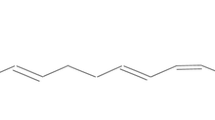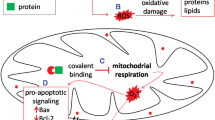Abstract
Background
Acetaminophen (APAP) overdose induces severe oxidative stress followed by hepatocyte apoptosis/necrosis. Previous studies have indicated that endoplasmic reticulum (ER) stress is involved in the cell death process. Therefore, we investigated the effect of the chemical chaperone 4-phenyl butyric acid (PBA) on APAP-induced liver injury in mice.
Methods
Eight-week-old male C57Bl6/J mice were given a single intraperitoneal (i.p.) injection of APAP (450 mg/kg body weight), following which some were repeatedly injected with PBA (120 mg/kg body weight, i.p.) every 3 h starting at 0.5 h after the APAP challenge. All mice were then serially euthanized up to 12 h later.
Results
PBA treatment dramatically ameliorated the massive hepatocyte apoptosis/necrosis that was observed 6 h after APAP administration. PBA also significantly prevented the APAP-induced increases in cleaved activating transcription factor 6 and phosphorylation of c-Jun N-terminal protein kinase and significantly blunted the increases in mRNA levels for binding immunoglobulin protein, spliced X-box binding protein-1, and C/EBP homologous protein. Moreover, PBA significantly prevented APAP-induced Bax translocation to the mitochondria, and the expression of heme oxygenase-1 mRNA and 4-hydroxynonenal. By contrast, PBA did not affect hepatic glutathione depletion following APAP administration, reflecting APAP metabolism.
Conclusions
PBA prevents APAP-induced liver injury even when an APAP challenge precedes its administration. The underlying mechanism of action most likely involves the prevention of ER stress-induced apoptosis/necrosis in the hepatocytes during APAP intoxication.





Similar content being viewed by others
Abbreviations
- ALT:
-
Alanine aminotransferase
- AST:
-
Aspartate aminotransferase
- ANOVA:
-
Analysis of variance
- eIF2α:
-
Eukaryotic initiation factor 2α
- ER:
-
Endoplasmic reticulum
- GAPDH:
-
Glyceraldehyde 3-phosphate dehydrogenase
- GRP78:
-
Glucose-regulated protein 78
- Bip:
-
Binding immunoglobulin protein
- H–E:
-
Hematoxylin–Eosin
- 4-HNE:
-
4-hydroxy-2-nonenal
- JNK:
-
c-Jun N-terminal kinase
- HO1:
-
Heme oxygenase-1
- NASH:
-
Non-alcoholic steatohepatitis
- sXBP1:
-
Spliced X-box binding protein-1
- UPR:
-
Unfolded protein response
- NAPQI:
-
N-acetyl-p-benzoquinone imine
- TUNEL:
-
Terminal deoxynucleotidyl transferase-mediated UTP end labeling
- ATF6:
-
Activating transcription factor 6
- IRE1α:
-
Inositol-requiring kinase 1α
- PERK:
-
Protein kinase RNA-like ER kinase
- HSP60:
-
Heat shock protein 60
- CHOP:
-
C/EBP homologous protein
- MPT:
-
Mitochondrial permeability transition
- ROS:
-
Reactive oxygen species
- PBA:
-
4-phenyl butyric acid
- UPR:
-
Unfolded protein response
References
Brune K, Renner B, Tiegs G. Acetaminophen/paracetamol: a history of errors, failures and false decisions. Eur J Pain. 2015;19:953–65.
Major JM, Zhou EH, Wong HL, et al. Trends in rates of acetaminophen-related adverse events in the United States. Pharmacoepidemiol Drug Saf. 2016;25(5):590–8.
Canbay A, Jochum C, Bechmann LP, et al. Acute liver failure in a metropolitan area in Germany: a retrospective study (2002–2008). Z Gastroenterol. 2009;47:807–13.
Krenzelok EP, The FDA. Acetaminophen advisory committee meeting—what is the future of acetaminophen in the United States? The perspective of a committee member. Clin Toxicol (Phila). 2009;47:784–9.
Xu C, Bailly-Maitre B, Reed JC. Endoplasmic reticulum stress: cell life and death decisions. J Clin Invest. 2005;115:2656–64.
Ferner RE, Dear JW, Bateman DN. Management of paracetamol poisoning. BMJ. 2011;342:d2218.
Zyoud SH, Al-Jabi SW, Sweileh WM, et al. Global research productivity of N-acetylcysteine use in paracetamol overdose: a bibliometric analysis (1976–2012). Hum Exp Toxicol. 2015;34:1006–16.
Sudo C, Maekawa K, Segawa K, et al. Trends in drug-induced liver injury based on reports of adverse reactions to PMDA in Japan. Kokuritsu Iyakuhin Shokuhin Eisei Kenkyusho Hokoku. 2012;130:66–70.
Chiew AL, Isbister GK, Duffull SB, et al. Evidence for the changing regimens of acetylcysteine. Br J Clin Pharmacol. 2016;81:471–81.
Doyle KM, Kennedy D, Gorman AM, et al. Unfolded proteins and endoplasmic reticulum stress in neurodegenerative disorders. J Cell Mol Med. 2011;15:2025–39.
Sano R, Reed JC. ER stress-induced cell death mechanisms. Biochim Biophys Acta. 2013;1833:3460–70.
Sasaki M, Yoshimura-Miyakoshi M, Sato Y, et al. A possible involvement of endoplasmic reticulum stress in biliary epithelial autophagy and senescence in primary biliary cirrhosis. J Gastroenterol. 2015;50:984–95.
Du RH, Tan J, Yan N, et al. Kir6.2 knockout aggravates lipopolysaccharide-induced mouse liver injury via enhancing NLRP3 inflammasome activation. J Gastroenterol. 2014;49:727–36.
Hamano M, Ezaki H, Kiso S, et al. Lipid overloading during liver regeneration causes delayed hepatocyte DNA replication by increasing ER stress in mice with simple hepatic steatosis. J Gastroenterol. 2014;49:305–16.
Narabayashi K, Ito Y, Eid N, et al. Indomethacin suppresses LAMP-2 expression and induces lipophagy and lipoapoptosis in rat enterocytes via the ER stress pathway. J Gastroenterol. 2015;50:541–54.
Prentice H, Modi JP, Wu JY. Mechanisms of neuronal protection against excitotoxicity, endoplasmic reticulum stress, and mitochondrial dysfunction in stroke and neurodegenerative diseases. Oxid Med Cell Longev. 2015;2015:964518.
Salvado L, Palomer X, Barroso E, et al. Targeting endoplasmic reticulum stress in insulin resistance. Trends Endocrinol Metab. 2015;26:438–48.
Zhang Q, Li Y, Liang T, et al. ER stress and autophagy dysfunction contribute to fatty liver in diabetic mice. Int J Biol Sci. 2015;11:559–68.
Hrincius ER, Liedmann S, Finkelstein D, et al. Acute lung injury results from innate sensing of viruses by an ER stress pathway. Cell Rep. 2015;11:1591–603.
Asano T, Sato A, Isono M, et al. Bortezomib and belinostat inhibit renal cancer growth synergistically by causing ubiquitinated protein accumulation and endoplasmic reticulum stress. Biomed Rep. 2015;3:797–801.
He J, Du L, Bao M, et al. Oroxin A inhibits breast cancer cell growth by inducing robust endoplasmic reticulum stress and senescence. Anticancer Drugs. 2016;27:204–15.
Zhang T, Kho DH, Wang Y, et al. Gp78, an E3 ubiquitin ligase acts as a gatekeeper suppressing nonalcoholic steatohepatitis (NASH) and liver cancer. PLoS One. 2015;10:e0118448.
Uzi D, Barda L, Scaiewicz V, et al. CHOP is a critical regulator of acetaminophen-induced hepatotoxicity. J Hepatol. 2013;59:495–503.
Nagy G, Kardon T, Wunderlich L, et al. Acetaminophen induces ER dependent signaling in mouse liver. Arch Biochem Biophys. 2007;459:273–9.
Song YF, Luo Z, Zhang LH, et al. Endoplasmic reticulum stress and disturbed calcium homeostasis are involved in copper-induced alteration in hepatic lipid metabolism in yellow catfish Pelteobagrus fulvidraco. Chemosphere. 2015;144:2443–53.
Kolb PS, Ayaub EA, Zhou W, et al. The therapeutic effects of 4-phenylbutyric acid in maintaining proteostasis. Int J Biochem Cell Biol. 2015;61:45–52.
Vilatoba M, Eckstein C, Bilbao G, et al. Sodium 4-phenylbutyrate protects against liver ischemia reperfusion injury by inhibition of endoplasmic reticulum-stress mediated apoptosis. Surgery. 2005;138:342–51.
Lichter-Konecki U, Diaz GA, Merritt JL 2nd, et al. Ammonia control in children with urea cycle disorders (UCDs); phase 2 comparison of sodium phenylbutyrate and glycerol phenylbutyrate. Mol Genet Metab. 2011;103:323–9.
Odievre MH, Brun M, Krishnamoorthy R, et al. Sodium phenyl butyrate downregulates endothelin-1 expression in cultured human endothelial cells: relevance to sickle-cell disease. Am J Hematol. 2007;82:357–62.
Collins AF, Pearson HA, Giardina P, et al. Oral sodium phenylbutyrate therapy in homozygous beta thalassemia: a clinical trial. Blood. 1995;85:43–9.
Morinaga M, Kon K, Saito H, et al. Sodium 4-phenylbutyrate prevents murine dietary steatohepatitis caused by trans-fatty acid plus fructose. J Clin Biochem Nutr. 2015;57:183–91.
Kon K, Ikejima K, Okumura K, et al. Diabetic KK-A(y) mice are highly susceptible to oxidative hepatocellular damage induced by acetaminophen. Am J Physiol Gastrointest Liver Physiol. 2010;299:G329–37.
Jo H, Choe SS, Shin KC, et al. Endoplasmic reticulum stress induces hepatic steatosis via increased expression of the hepatic very low-density lipoprotein receptor. Hepatology. 2013;57:1366–77.
Harding HP, Zhang Y, Ron D. Protein translation and folding are coupled by an endoplasmic-reticulum-resident kinase. Nature. 1999;397:271–4.
Ma Y, Hendershot LM. Delineation of a negative feedback regulatory loop that controls protein translation during endoplasmic reticulum stress. J Biol Chem. 2003;278:34864–73.
Shen J, Chen X, Hendershot L, et al. ER stress regulation of ATF6 localization by dissociation of BiP/GRP78 binding and unmasking of Golgi localization signals. Dev Cell. 2002;3:99–111.
Yoshida H, Okada T, Haze K, et al. ATF6 activated by proteolysis binds in the presence of NF-Y (CBF) directly to the cis-acting element responsible for the mammalian unfolded protein response. Mol Cell Biol. 2000;20:6755–67.
Fu HY, Minamino T, Tsukamoto O, et al. Overexpression of endoplasmic reticulum-resident chaperone attenuates cardiomyocyte death induced by proteasome inhibition. Cardiovasc Res. 2008;79:600–10.
Yoshida H, Matsui T, Yamamoto A, et al. XBP1 mRNA is induced by ATF6 and spliced by IRE1 in response to ER stress to produce a highly active transcription factor. Cell. 2001;107:881–91.
Du K, Xie Y, McGill MR, et al. Pathophysiological significance of c-jun N-terminal kinase in acetaminophen hepatotoxicity. Expert Opin Drug Metab Toxicol. 2015;11:1769–79.
Saito C, Lemasters JJ, Jaeschke H. c-Jun N-terminal kinase modulates oxidant stress and peroxynitrite formation independent of inducible nitric oxide synthase in acetaminophen hepatotoxicity. Toxicol Appl Pharmacol. 2010;246:8–17.
McCullough KD, Martindale JL, Klotz LO, et al. Gadd153 sensitizes cells to endoplasmic reticulum stress by down-regulating Bcl2 and perturbing the cellular redox state. Mol Cell Biol. 2001;21:1249–59.
Puthalakath H, O’Reilly LA, Gunn P, et al. ER stress triggers apoptosis by activating BH3-only protein Bim. Cell. 2007;129:1337–49.
Lee CH, Kuo CY, Wang CJ, et al. A polyphenol extract of Hibiscus sabdariffa L. ameliorates acetaminophen-induced hepatic steatosis by attenuating the mitochondrial dysfunction in vivo and in vitro. Biosci Biotechnol Biochem. 2012;76:646–51.
Bulku E, Stohs SJ, Cicero L, et al. Curcumin exposure modulates multiple pro-apoptotic and anti-apoptotic signaling pathways to antagonize acetaminophen-induced toxicity. Curr Neurovasc Res. 2012;9:58–71.
Xu C, Xu W, Palmer AE, et al. BI-1 regulates endoplasmic reticulum Ca2+ homeostasis downstream of Bcl-2 family proteins. J Biol Chem. 2008;283:11477–84.
Kon K, Kim JS, Uchiyama A, et al. Lysosomal iron mobilization and induction of the mitochondrial permeability transition in acetaminophen-induced toxicity to mouse hepatocytes. Toxicol Sci. 2010;117:101–8.
Uchiyama A, Kim JS, Kon K, et al. Translocation of iron from lysosomes into mitochondria is a key event during oxidative stress-induced hepatocellular injury. Hepatology. 2008;48:1644–54.
Simmen T, Lynes EM, Gesson K, et al. Oxidative protein folding in the endoplasmic reticulum: tight links to the mitochondria-associated membrane (MAM). Biochim Biophys Acta. 2010;1798:1465–73.
Salem IB, Prola A, Boussabbeh M, et al. Activation of ER stress and apoptosis by alpha- and beta-Zearalenol in HCT116 cells, protective role of Quercetin. Neurotoxicology. 2016;53:334–42.
Zhong D, Wang H, Liu M, et al. Ganoderma lucidum polysaccharide peptide prevents renal ischemia reperfusion injury via counteracting oxidative stress. Sci Rep. 2015;5:16910.
Egnatchik RA, Leamy AK, Jacobson DA, et al. ER calcium release promotes mitochondrial dysfunction and hepatic cell lipotoxicity in response to palmitate overload. Mol Metab. 2014;3:544–53.
Xie Y, McGill MR, Dorko K, et al. Mechanisms of acetaminophen-induced cell death in primary human hepatocytes. Toxicol Appl Pharmacol. 2014;279:266–74.
Larson AM. Acetaminophen hepatotoxicity. Clin Liver Dis. 2007;11:525–48 (vi).
Lauterburg BH, Corcoran GB, Mitchell JR. Mechanism of action of N-acetylcysteine in the protection against the hepatotoxicity of acetaminophen in rats in vivo. J Clin Invest. 1983;71:980–91.
Gilbert J, Baker SD, Bowling MK, et al. A phase I dose escalation and bioavailability study of oral sodium phenylbutyrate in patients with refractory solid tumor malignancies. Clin Cancer Res. 2001;7:2292–300.
Shimizu D, Ishitsuka Y, Miyata K, et al. Protection afforded by pre- or post-treatment with 4-phenylbutyrate against liver injury induced by acetaminophen overdose in mice. Pharmacol Res. 2014;87:26–41.
Acknowledgments
The authors thank Takako Ikegami and Tomomi Ikeda (Laboratory of Molecular and Biochemical Research, Research Support Center, Juntendo University Graduate School of Medicine, Tokyo, Japan) and Maiko Suzuki and Ryota Kitagawa (Department of Gastroenterology, Juntendo University School of Medicine, Tokyo, Japan) for technical assistance and R. F. Whittier for critical reading of the manuscript and thoughtful discussions.
Author information
Authors and Affiliations
Corresponding author
Ethics declarations
Conflict of interest
The authors declare that they have no conflict of interest.
Financial support
This work was supported in part by JSPS KAKENHI (24590995 to K.K., 24590996 to K.I., 24390191 to S.W.).
Rights and permissions
About this article
Cite this article
Kusama, H., Kon, K., Ikejima, K. et al. Sodium 4-phenylbutyric acid prevents murine acetaminophen hepatotoxicity by minimizing endoplasmic reticulum stress. J Gastroenterol 52, 611–622 (2017). https://doi.org/10.1007/s00535-016-1256-3
Received:
Accepted:
Published:
Issue Date:
DOI: https://doi.org/10.1007/s00535-016-1256-3




